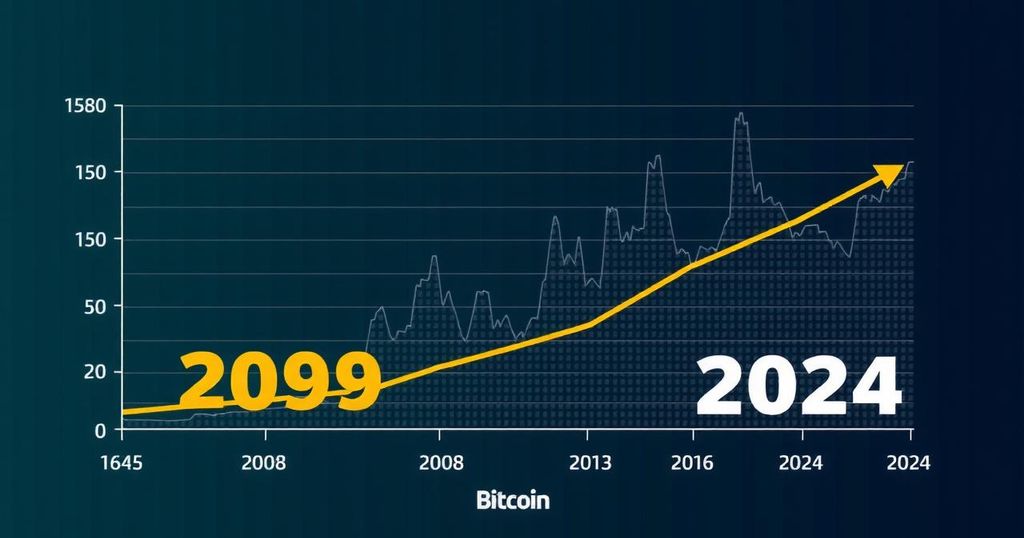A Comprehensive Overview of Bitcoin’s Price Journey: 2009 to 2024
Since its inception in January 2009, Bitcoin has experienced significant fluctuations in its value, characterized by a generally upward trajectory referred to colloquially as “up and to the right.” Bitcoin, which heralded the cryptocurrency era, initially gained little attention from the general public. However, within a short period of just over a decade, it has emerged as a highly intriguing trading opportunity that has created substantial wealth for numerous investors. Many individuals have become millionaires through Bitcoin trading, while long-term holders—often referred to as “HODLers”—have also reaped significant rewards.
Despite its remarkable long-term appreciation, Bitcoin has faced numerous downturns, most notably from November 2021 to 2022 when expectations of rising interest rates and tightening financial liquidity adversely affected its value.
Bitcoin was born out of the turmoil following the global financial crisis, credited to the enigmatic entity known as Satoshi Nakamoto. Early advocates heralded Bitcoin as a means of decentralizing monetary policy, transitioning control from governments and central banks to a self-regulated digital environment. With a capped supply of 21 million coins, the increasing demand for Bitcoin has contributed to its meteoric rise in value, attracting numerous speculators eager to capitalize on anticipated price increases.
The price of Bitcoin is notoriously influenced by market sentiment, oscillating between phases of greed and fear. During times of heightened optimism, Bitcoin prices can soar amidst dreamy expectations, while negative news can trigger sharp declines as sellers dominate the market. Although Bitcoin has been touted as a medium of exchange, practical uses in everyday transactions have been limited, prompting a shift in its perception towards being a store of value, often compared to gold. Nonetheless, Bitcoin’s history as a value store is still nascent in comparison to gold’s extensive legacy.
Early Years (2009 to 2013): The Rise of Bitcoin
Bitcoin’s journey commenced modestly in 2009 when it was first traded against the US dollar in late 2009 at an unprecedented low price, equivalent to merely one-tenth of one cent. By mid-2010, initial pricing data emerged, marking the first recorded instance of Bitcoin being utilized for a real-world purchase—a transaction involving 10,000 bitcoins exchanged for two pizzas, which has since become legendary within the cryptocurrency community. Throughout 2010, Bitcoin struggled to maintain its appeal, with prices peaking at $0.40. In 2011, Bitcoin’s price spiked to approximately $30 before plummeting to $2, ending the year at about $4.70. The subsequent year, 2012, marked a period of consolidation following a “halving” event which reduced mining rewards and set the stage for future appreciation.
Emergence into Mainstream Awareness (2013 to 2017)
In 2013, Bitcoin began to capture the attention of the broader public, catalyzed by the installation of the world’s first Bitcoin ATM in Vancouver. The price ascended dramatically, topping $1,200 by late November but closing the year at a more subdued $805 due to renewed regulatory concerns. Bitcoin continued to exhibit its legendary volatility into 2014, where after peaking at $1,000, it saw a dramatic decline attributed largely to events surrounding the Mt. Gox exchange. Following extensive fluctuation throughout 2015 and 2016, 2017 culminated in an explosive run, hitting nearly $20,000 in December, driven largely by unprecedented public enthusiasm and the introduction of Bitcoin futures trading.
Post-Market Excitement (2018 to 2020)
However, the euphoric surge into 2018 transitioned into a year marked by drastic decline, with Bitcoin closing at just over $3,700, down 73% from its previous peak. The following year, recovery was evident as Bitcoin navigated periods of price swings, ultimately finishing 2019 at just below $7,200. In 2020, Bitcoin surged significantly, finishing the year near $29,000, bolstered by increased institutional interest and expansive monetary policy to counteract the economic impacts of the pandemic.
Recent Trends (2021 to 2024)
As 2021 commenced, Bitcoin swiftly breached $64,000 but faced significant headwinds from regulatory pressures imposed by China, which catalyzed a notable decline. Despite these challenges, Bitcoin reached a new peak of $68,789 in November 2021. The year 2022 was characterized by ongoing volatility as interest rates began to rise, leading to significant price contractions for Bitcoin. 2023 witnessed a resurgence, with Bitcoin trending upwards and culminating in a price near $27,000 by late September. As of October 2023, Bitcoin experienced renewed momentum, soaring to above $42,000 due to favorable regulatory developments.
In early January 2024, the SEC approved Bitcoin ETFs, resulting in a peak price of nearly $49,000 shortly before their launch. Throughout 2024, Bitcoin reached an all-time high exceeding $73,000 in March as investment flowed into ETFs, although subsequently retracing below $58,000 by September.
This comprehensive overview illustrates Bitcoin’s tumultuous yet exhilarating journey towards mainstream acceptance and highlights the importance of mindful investment strategies within this volatile market.








Post Comment